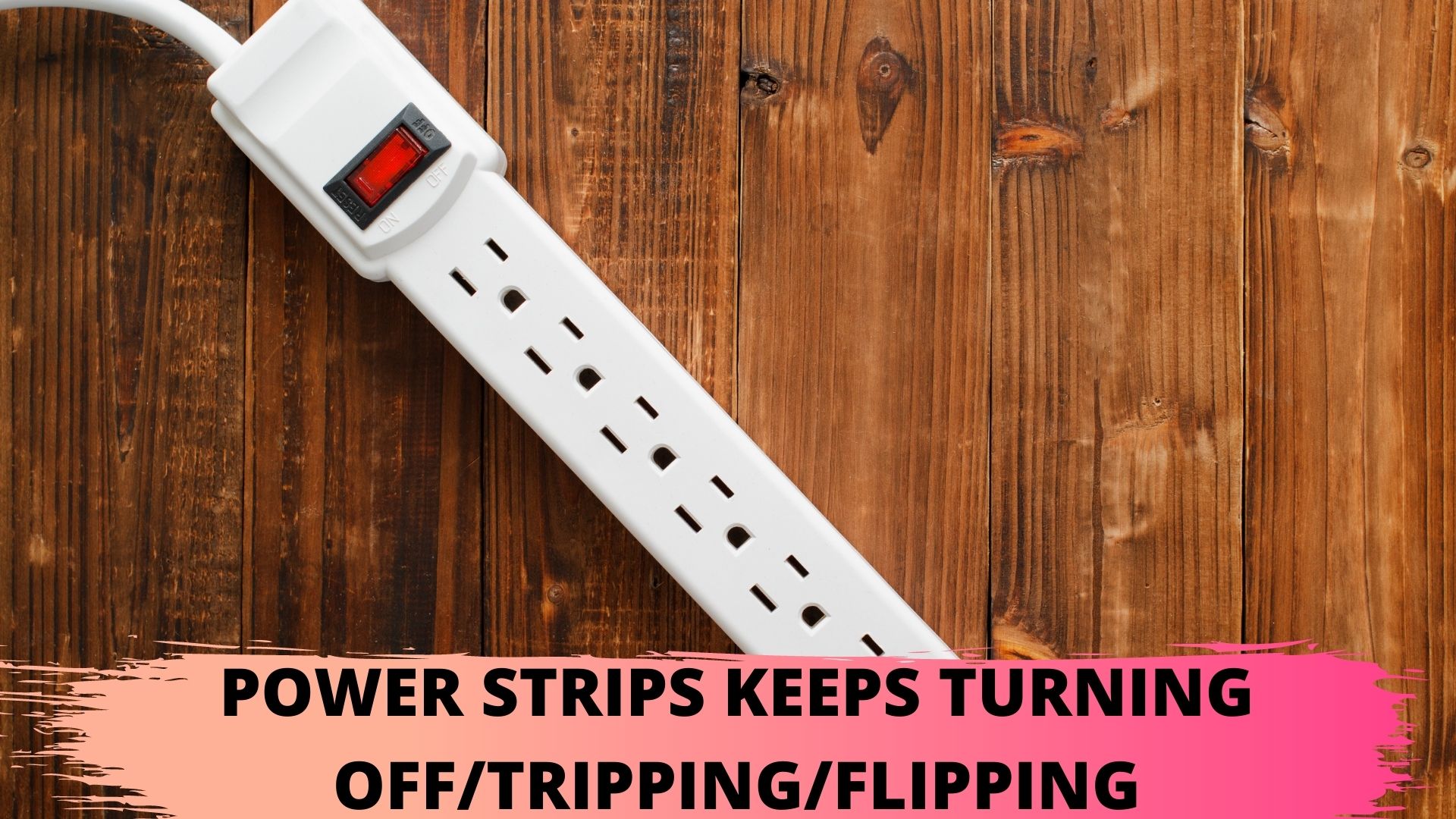Power strips and surge protectors are not the same things. A power strip is just an extension cord. It attracts a lot of interest from homeowners because it has several outlets. You can use it to power multiple appliances. However, it cannot protect those appliances from electrical surges.
If your power strip is tripping, flipping, turning off, or clicking, you have to first determine whether or not it has integrated surge protection mechanisms. An ordinary power strip can turn off for any number of reasons but it is unlikely to click.
If your power strip is clicking, it probably contains surge protection which is good news because it suggests that your appliances are protected against dangerous surges.
Why Power Strip Keeps Turning Off?
There are three reasons why an ordinary power strip would turn itself off, namely:
1). Overload
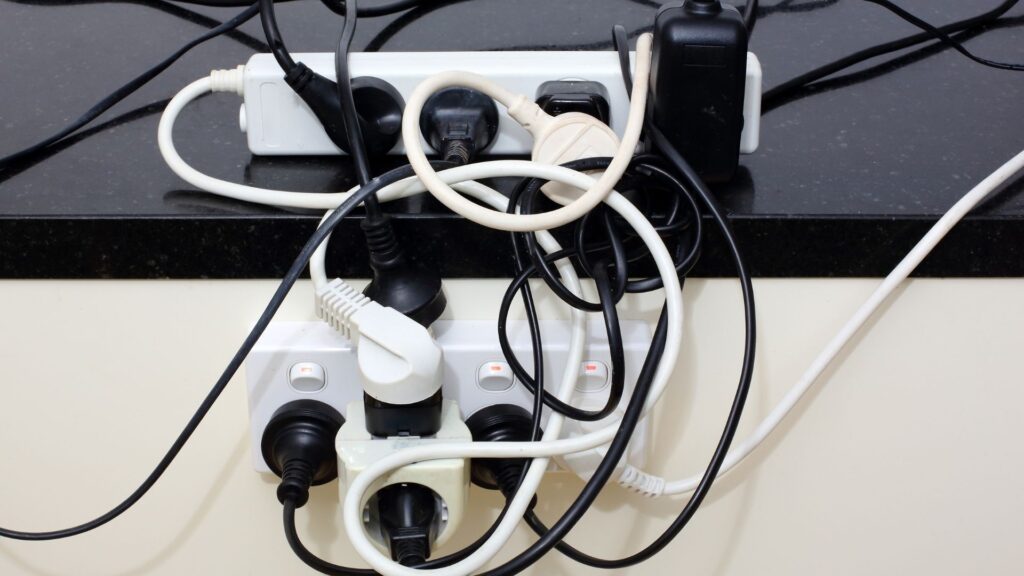
A power strip will shut off if it is overloaded by a surge of electricity. Sometimes, your power supply system is to blame for the overload. But in many cases, people overload their power strips by using them to operate powerful appliances like refrigerators.
- Read Is a surge protector necessary for a refrigerator?
- Read Can You Plug A Freezer Into A Power Strip? (Know It Now!)
You can also achieve similar results by using the strip to operate an excessive number of appliances. Power strips are designed to contend with a particular wattage. If the appliances attached exceed the rating of the power strip, it will turn off.
Some power strips will go off and stay off. Others will switch off and then switch back on after a few minutes or even seconds. Some power strips will turn a few of the appliances off while leaving others untouched.
In a lot of cases, unplugging one or more appliances will reduce the load on the power strip. This will prevent it from turning off unexpectedly.
A powerful surge is more than capable of destroying your power strip and all the appliances attached, particularly if the power strip lacks surge protection.
2). Faulty Wiring
Hunker blames a lot of the tripping you see in power strips on loose or faulty wires. Frayed wires and loose connections cause electricity to flow in unstable quantities. A power strip with surge protection will react to this instability by shutting the circuit off to protect your appliances.
3). Low-Quality Components
Some power strips are simply faulty. They are either poorly designed or they have defective components that make them more susceptible to what Legrand calls nuisance tripping.
- Read Can power strips get wet?
Why Power Strip Keeps Clicking?
Clicking is most commonly found in surge protectors or power strips with surge protection. As was mentioned above, surge protection is designed to defend your electronic devices from dangerous surges of electricity.
The mechanism achieves this objective by redirecting electrical surges to the ground wire. When this happens, your surge protector will generate a click. Every time you hear that click, it means that the surge protector has reacted to an electrical surge.
In other words, it is a good thing. It means that the surge protection in your power strip is performing its role.
Potential causes of electrical surges include:
1). Lightening

Lightening is capable of generating millions of volts of electricity. If it strikes the power lines in your area, it can funnel more electricity than your power strip can handle into your home, triggering the surge protection mechanisms.
2). Overload Due To Appliances
Appliances such as blenders and vacuum cleaners can overload your power strip by causing small surges of electricity. If you pay close attention, you will hear several clicks whenever you activate these devices. This will warn you against overloading the power strip.
How to Avoid tripping/flipping/clicking/turning off?
While electrical surges are sometimes unavoidable, there are ways to minimize the number of times your power strip flips, trips, clicks, and turns off. For instance:
1). Surge Protectors
Cnet wants you to learn to differentiate between surge protectors and power strips. Yes, some power strips have surge protection but you have to make a deliberate effort to identify them. Don’t assume that every power strip doubles as a surge protector.
A power strip that lacks surge protection might respond to an electrical surge by turning off. But it could also destroy your appliances in the long run.
2). Surge Protection
Some people believe that the majority of power strips on the market today have surge protection. But you shouldn’t make this assumption. I want you to look for the ‘UL1449‘ mark.
The label proves that a particular power strip has surge protection. The absence of this label means that the power strip is just an extension cord with multiple outlets. It won’t protect your appliances from electrical surges.
3). Use Lower Voltage Rating
Look at the specs of a power strip before you buy it. Pay close attention to the joules (or resistance) and the suppressed voltage rating. The more joules, the greater the surge protection. On the other hand, you want a much lower voltage rating (power strips range between 330 and 4000 volts).
The lowest voltage ratings produce surge protectors with the fastest reactions. As a homeowner, you want surge protection that will shut your appliance off before an electrical surge can destroy it.
A lower voltage rating can give you the rapid response you require.
4). Wear and Tear – Replace The Power Strip
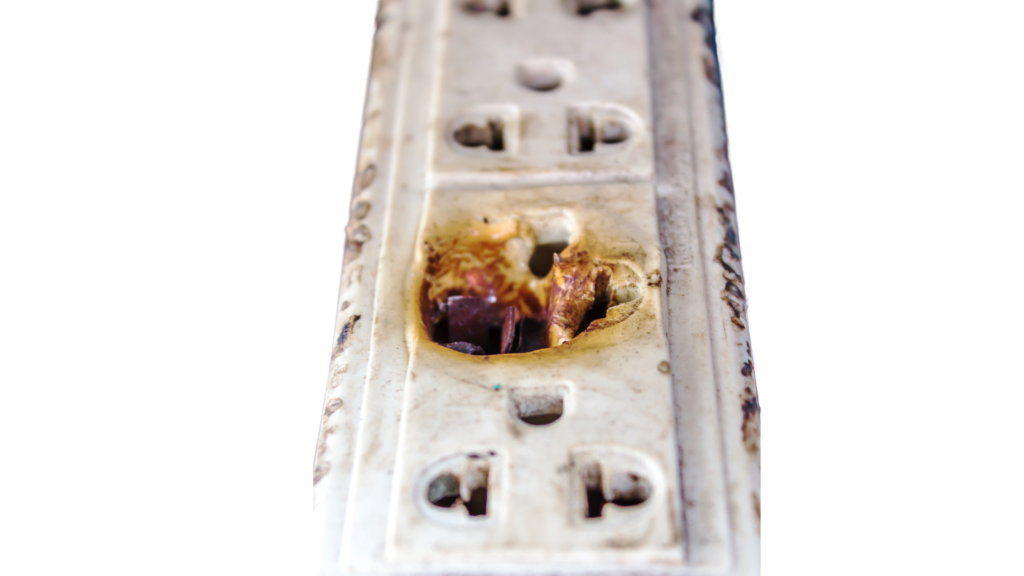
Power strips have a limit beyond which they will stop working. But you don’t have to wait for years or even months before you replace a power strip. Whenever the device’s surge protection is tripped, the chances that the electrical surge in question destroyed vital components are high. The power strip is less likely to offer you the same protection next time.
This is why some experts in the field encourage homeowners to replace a power strip whenever it is tripped.
5). Use Power Strip According To Its Capacity
The capacity of a power strip is determined by the amperage rating. From what Roman Electric says, you should acquire a power strip whose capacity can accommodate the appliances you plan to connect.
For instance, light-duty power strips (1-13 Amp rating) are suitable for small items like fans and lamps. Heavy-duty power strips (16-20 Amp rating), on the other hand, are capable of meeting the needs of heavy-duty items like saws and air compressors.
Electricians will discourage you from pairing heavy-duty items with power strips and extension cords. But an extension cord with the right capacity will accommodate heavy-duty appliances without tripping.
More Details To Know
A power strip is supposed to protect your electronic devices from electrical surges. This assumes that it has surge protection. It sits between the wall outlet and your appliances. People argue that it also saves energy by preventing the so-called vampire draw.
When you unplug it, you can switch all your appliances off at once. But what if you haven’t unplugged the power strip? What if you have simply switched it off? Will this have the same impact as unplugging it? That is the question we intend to answer.
What is Vampire Draw?
Before you can determine whether turning a power strip off is the same as unplugging it, you must first understand the role it plays, specifically with regards to vampire draw.
The term refers to an electronic gadget’s ability to use electricity even when it is switched off. Devices such as television sets and DVD players have a state known as ‘standby mode’.
In this state, the devices look like they have been switched off. According to Wikipedia, you can switch an electronic device such as a television set off completely by disconnecting it from the power source.
If you turn it off by pressing a button on a remote, you have merely allowed the device to enter standby mode. In this mode, the device will draw enough power from the wall outlet to affect your electricity bill in the long run.
This is where power strips enter the picture. If you plug all your electronic devices into a power strip, unplugging the power strip will turn them all off. They won’t enter standby mode. As such, you don’t have to worry about the vampire draw.
You can achieve similar results without the use of a power strip. It isn’t that difficult to unplug a television set from its wall outlet. However, if you have multiple devices, you might forget to disconnect some of them from their power source. But if they are all plugged into a power strip, unplugging the power strip will disconnect them all from their power source.
Is Turning Off Power Strip the Same as Unplugging It?
Yes. As far as USA Today is concerned, turning a power strip off achieves the same results as unplugging it. The cord leading to the wall outlet may have electricity. However, by flipping the switch to the ‘Off’ position, you have made it impossible for a circuit to complete. Therefore, the outlets on the power strip don’t have access to electricity.
You can rest easy knowing that the ‘Off’ switch on your power strip will prevent your electronic devices from entering standby mode and drawing upon your home’s electricity even when they are not in use. You should know that this only applies to power strips whose ‘Off’ switch is working. Some power strips are defective.
Do Power Strips Use Electricity When Turned Off?
In most cases, a power strip doesn’t use electricity when it is turned off. As was mentioned above, the wires leading to the wall outlet might have electricity. But you can’t use that electricity when the power strip is switched off.
This is true for all the electrical wiring in your home. It will continue to hold electricity even after you have switched all the electronic components off, including the lights. However, the power company won’t charge you for that electricity because it isn’t being used.
Some power strips have a special light that remains on even when the power strip has been switched off. This light will continue to use electricity. However, the quantities it consumes are tiny. In fact, they are unlikely to amount to a single cent over the course of a year. They are so negligible that they won’t affect your electric bill.
For that reason, most people don’t count the electricity that light uses. As far as they are concerned, power strips, even the ones with lights, don’t use electricity when they are turned off.
Can a Power Strip Turn Itself Off?
Yes, it can. If you have an ordinary power strip, when it encounters a surge of electricity, it will permit that surge to reach the appliances you have attached, potentially destroying them.
But, a power strip with surge protection mechanisms can protect your appliances by shutting down in the face of an electrical surge. Power strips of this sort feature circuit breakers.
You can cause a power strip to shut itself off by using it to operate an appliance that exceeds the wattage it was designed to handle.
Why Do Power Strips have a ‘Reset’ Button?
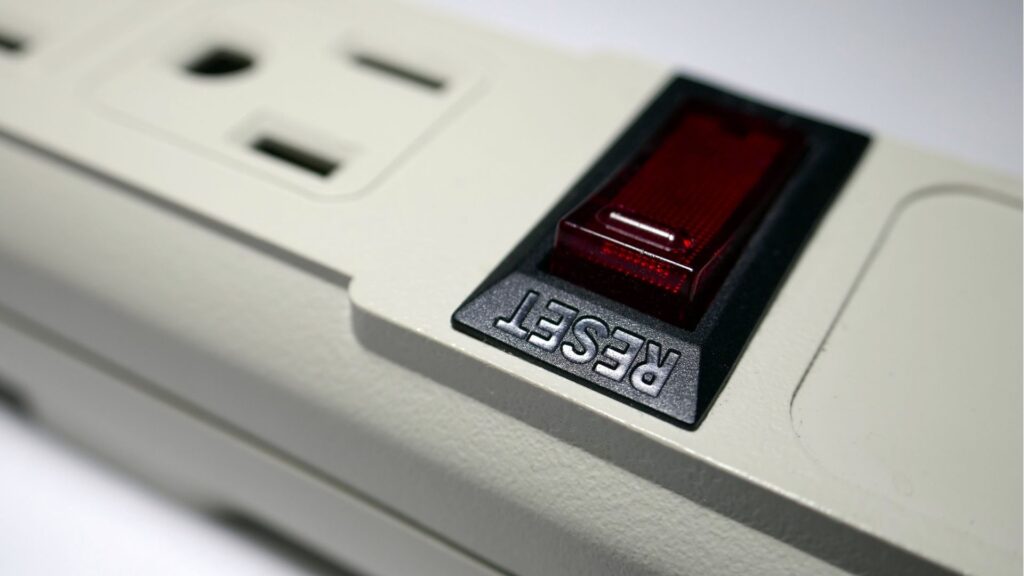
Some power strips have a ‘Reset’ button whose purpose tends to elude users. The ‘Reset’ button works with the circuit breaker. The circuit breaker trips whenever you overload the power strip. Pressing the ‘Reset’ button resets the breaker. But you should only do this after eliminating the source of the overload.
The Case for Smart Power Strips
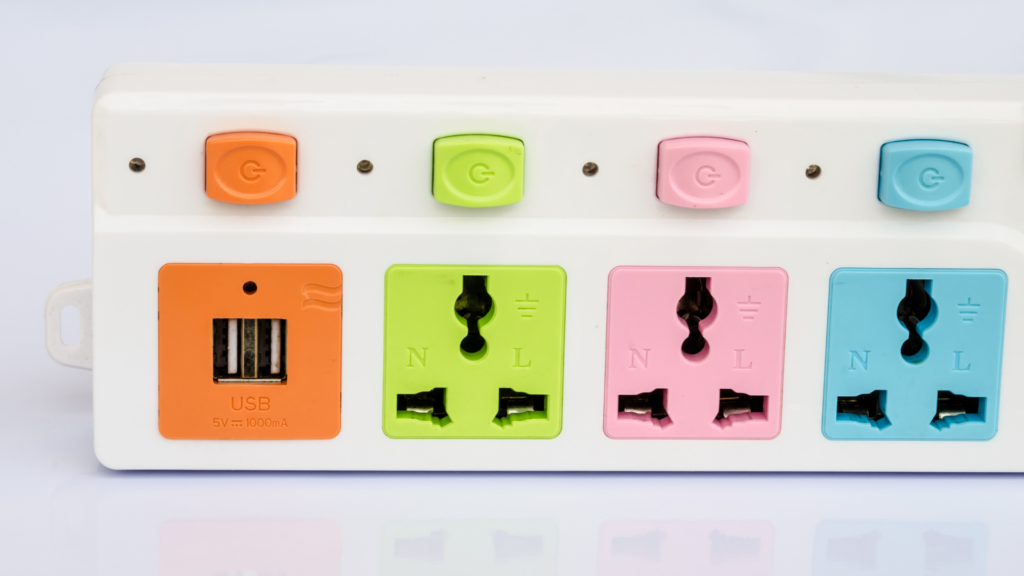
Power strips are supposed to prevent devices such as computers and television sets from entering standby mode and using your electricity when they are supposed to be off. Once you switch a power strip off, it disconnects these appliances from their power source.
But energy.gov has noted that this isn’t always an attractive solution. This is because certain devices, such as alarm clocks and refrigerators, are supposed to remain on. You want to keep them plugged in.
And if you switch their power strip off in an effort to deactivate unnecessary gadgets like DVD players and printers, you will also turn the vital appliances off. This is why smart power strips are gaining so much traction.
They provide the same convenience as a traditional power strip, that is to say, you can use them to meet the power needs of multiple appliances at the same time. However, smart power strips are intelligent enough to know when a connected appliance has entered into standby mode.
When they detect this change, they will disconnect the power to that outlet without affecting the other electronic devices.
In other words, a smart power strip will cut the power to your printer when it enters standby mode without affecting the refrigerator even though they are both connected to the same power strip. Some power strips are so intelligent that they can detect motion.
HowStuffWorks is especially impressed with the ‘Isole IDP 3050’ which activates the power in its outlets when you enter the room and deactivates them when you leave the room.
Conclusion
Like all electric devices, power strips have a limit. They are designed to receive and transmit a certain amount of power. If they are forced to withstand electrical surges that exceed their limit, they will either redirect the excess power (if they have surge protection) or turn off.
You can protect your power strip from overload by limiting the number of appliances you plug into it. You should also purchase power strips whose voltage and amperage ratings are suitable for the purposes you have in mind.
Power strips are quite commonplace because they are so convenient to use. They give you complete control over the power needs of multiple appliances. You can use them to switch all your appliances on and off at the same time.
You can also prevent the vampire draw associated with the ‘standby mode’ in many electronic devices by either unplugging the power strip or turning it off. The result is the same. The power strip will disconnect your electronic items from their power source, preventing them from using electricity when you are absent.
Related Post:

